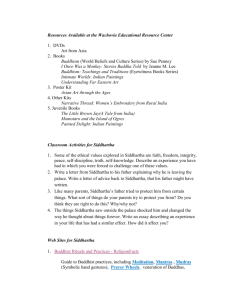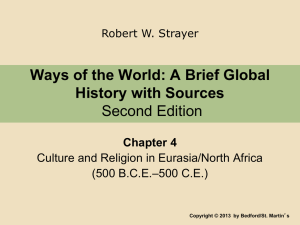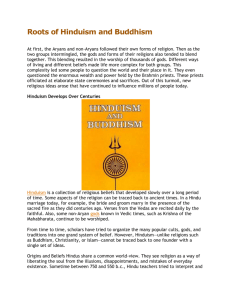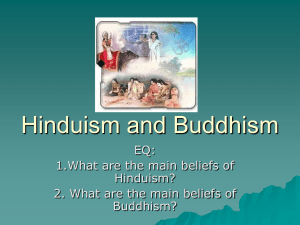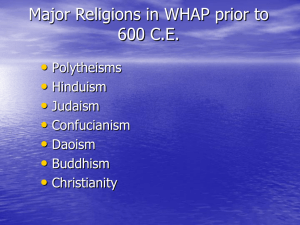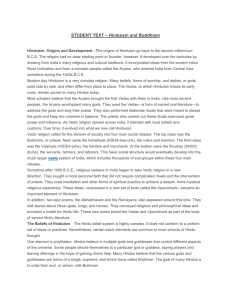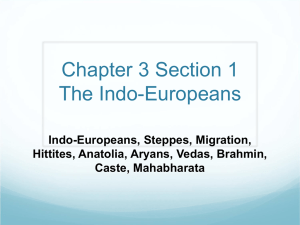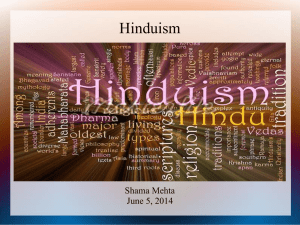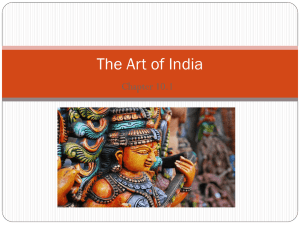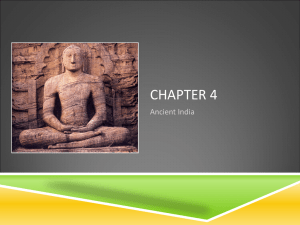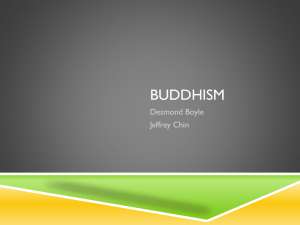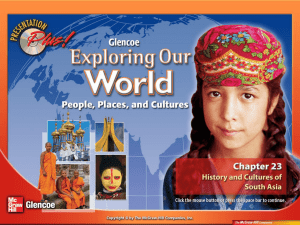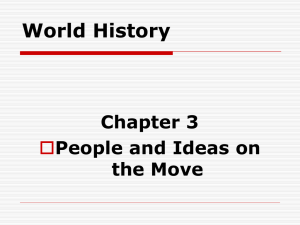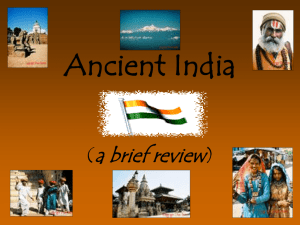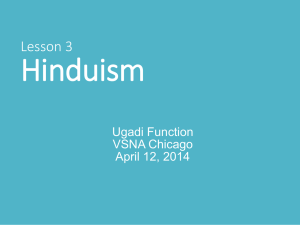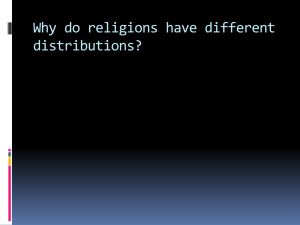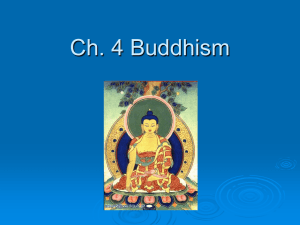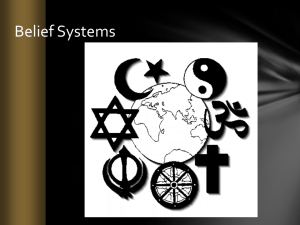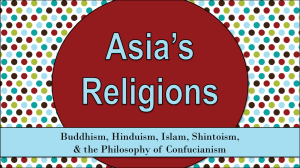PPT - Hinduism and Buddhism
advertisement
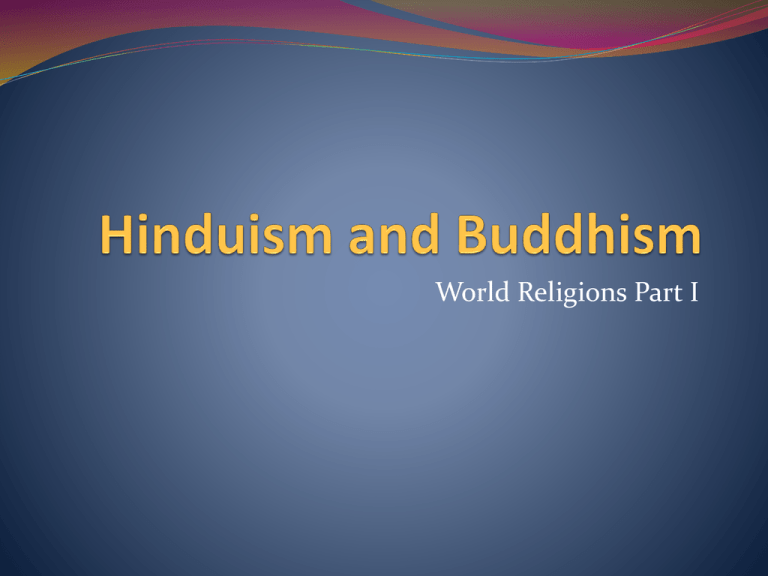
World Religions Part I Bellwork Survey the text and pictures on p.p 288- 289 to introduce you to Hinduism Then survey the text and pictures on p.p. 284-285 to introduce you to Buddhism 5 Minutes A. Roots of Hinduism B. Origins and Beliefs C. Hinduism Changes and Develops D. Hinduism and Society Roots of Hinduism Hinduism is a collection of religious beliefs that developed slowly over time Its ritual and practice today is the same as it was centuries ago Hindu beliefs are based on the traditions of the Aryans, a group of people who migrated into the Indus River valley in India around 1500 B.C. Roots of Hinduism The sacred literature of the Aryans were the Vedas The Vedas were four collections of prayers, magical spells, and instructions for performing rituals Sometime between 750 B.C. and 550 B.C., Hindu teachers tried to interpret and explain the hidden meanings of the Vedic hymns These teachings were later recorded to form the Upanishads Origins and Beliefs To Hindus, religion is a way of freeing the soul from the illusions, disappointments, and mistakes of everyday existence The Upanishads focus on how a person can achieve liberation from desires and suffering A Hindu achieves moksha when one achieves perfect understanding of all things Origins and Beliefs Hindus realize this may not be achieved in one lifetime so they believe in reincarnation An individual’s soul can be reborn again and again until achieving moksha A soul’s karma – good or bad deeds – follows from one incarnation to another, influencing life circumstances Hinduism Changes and Develops Hindus believe in a world soul called Brahman Brahman is seen as having the personalities of three gods Brahma = creator Vishnu = protector Shiva = destroyer These aspects of Brahman would often take on other forms resulting in thousands of “versions” of the one world soul Hinduism Changes and Develops Today, Hindus are free to choose the deity they worship or to choose none at all There are also three different paths to achieve moksha Path of right thinking Path of right action Path of religious devotion Hinduism and Society Today, even in the most ordinary activities of daily life, Hindus turn to their religion for guidance. Ritual Each year, thousands of Hindus make a pilgrimage to India’s Ganges River. The Ganges is considered a sacred site in the Hindu religion. Most Hindus come to bathe in the water, an act they believe will cleanse and purify them. The sick and disabled come in the belief that the holy water might cure their ailments. Leadership Gurus, or spiritual teachers, play a major role in spreading Hindu beliefs. These holy men are believed to have had the gods’ words revealed to them. Brahmin priests, like the one shown here, are also religious leaders. They take care of the divine images in the temples and read from the sacred books. A. Siddhartha’s Quest B. Origins and Beliefs C. Buddhism and Society D. Trade and Spread of Buddhism Backstory Buddhism developed out of the same period of religious questioning that shaped modern Hinduism The founder of Buddhism, Siddhartha Gautama was born into a noble family that lived in in the foothills of the Himalayas in Nepal According to Buddhist legend, the baby exhibited the marks of a great man Backstory A prophecy indicated that if the child stayed at home he was destined to become a world ruler If the child left home, however, he would become a universal spiritual leader Read more about this story in Historymakers on page 68 of your textbook Siddhartha’s Quest To foil the prophecy, Siddhartha’s father kept him isolated in the palace Siddhartha always dreamed of what it was like outside the walls When he was 29, he ventured outside the palace four times Siddhartha’s Quest First he saw an old man, next a sick man, then a corpse, and finally a wandering holy man who seemed at peace with himself. Siddhartha understood these events to mean that every living thing experiences old age, sickness, and death and that only a religious life offers a refuge from this inevitable suffering. Siddhartha decided to spend his life searching for religious truth and an end to life’s suffering Siddhartha’s Quest Read the second paragraph under this heading to discover Siddhartha’s search for enlightenment Origins and Beliefs The Buddha preached his first sermon to five companions who had accompanied him on his wanderings In it, he laid out the four main ideas that he had come to understand in his enlightenment. He called those ideas the Four Noble Truths Origins and Beliefs First Noble Truth Life is filled with suffering and sorrow. Second Noble Truth The cause of all suffering is people’s selfish desire for the temporary pleasures of this world. Third Noble Truth The way to end all suffering is to end all desires. Fourth Noble Truth The way to overcome such desires and attain enlightenment is to follow the Eightfold Path, which is called the Middle Way between desires and self-denial The Middle Way The idea was to master one step at a time – often taking more than one lifetime (reincarnation, right?) Read how the Buddha describes the Middle Way on page 69 By following the Middle Way one could achieve nirvana, the Buddha’s word for release from selfishness and pain Origins and Beliefs The Buddha rejected the many gods of Hinduism Instead, he taught a way of enlightenment The final goals of both religions—moksha for Hindus and nirvana for Buddhists—are similar Both involve a perfect state of understanding and a break from the chain of reincarnations ▲ Buddhist monks view a temple at Angkor Wat in Cambodia Buddhism and Society Many of the Buddha’s early followers included laborers and craftspeople Monks and nuns took vows (solemn promises) to live a life of poverty, to be nonviolent, and not to marry They wandered throughout India spreading the Buddha’s teachings Buddhism and Society The teachings of the Buddha were written down shortly after his death Buddhist sacred literature also includes commentaries, rules about monastic life, manuals on how to meditate, and legends about the Buddha’s previous reincarnations (the Jatakas) Leadership Those who dedicate their entire life to the teachings of the Buddha are known as Buddhist monks and nuns. In many Buddhist sects, monks are expected to lead a life of poverty, meditation, and study. Here, Buddhist monks file past shrines in Thailand. To learn humility, monks must beg for food and money. Trade and Spread of Buddhism As important as missionaries were to the spread of Buddhism, traders played an even more crucial role in this process Along with their products, traders carried Buddhism beyond India to Sri Lanka Buddhist religion was also brought southeast along trade routes to Burma, Thailand, and the island of Sumatra Trade and Spread of Buddhism Likewise, Buddhism followed the Central Asian trade routes, called the Silk Roads, all the way to China The movement of trade thus succeeded in making Buddhism the most widespread religion of East Asia Throughout human history, TRADE has been a powerful force for the spread of ideas Connect to Today by reading about the spread of Buddhism in the West on page 71


